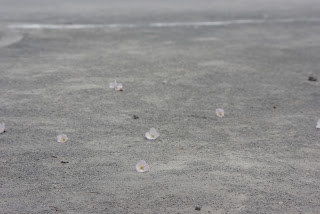The idle monkey trainer recently took a few days off from
not training monkeys to enjoy the sites, sun, snow and brews of South Lake
Tahoe. If there is any less encouraging way to start a ski weekend, it was the
snowless drive from San Francisco to South Lake Tahoe. In the dark we could not
see the mountain, but were not encouraged when a local told us “it hasn’t
snowed in two months.” “December,” confirmed his companion.
Day 1
Our first day on the slopes was a rough start, owing to a
rather foolish decision to continue exploring the various nightlife
opportunities that exist along the California-Nevada state line.
The Heavenly gondola takes off from US 50 just off the lake
shore and does not stop for two miles and 1000 vertical feet. We took more
local advice and started on the California side and were pleasantly surprised
by the conditions. The snow was packed, but given that it was 45F at the base
when we got up, we had expected slush at best. The cloudless blue sky left
stunning views out over the lake.
Our group ended the day at Heavenly’s new lodge at the top
of the gondola for some happy hour beers and views of the Heavenly Angels. On Thursdays
and Fridays the lodge happy hour blasts loud tunes as go-go dancing Angels gyrate
to the beat and drinks go at half-price. This takes drink prices back to normal
from ski lodge level.
I will mention dinner at a small Italian place only for the
two-sentence review that summed it up perfectly: “Despite being on the ground
level, it had all the ambiance of a basement. But, the food was good.”
Day 2
There were clouds in the sky when we awoke on the second day
of skiing, but this was no indication of cooler temperatures. We circled around
to the north end of the Lake and the posh resort of Northstar. The crowds at
the base had us a bit concerned about lift lines and crowded slopes, but this
is an area at least as much about the idea of going skiing as it is about
actually skiing.
On the mountain we found it fairly easy to avoid the crowds,
and even found a few groomed blacks that had seen so few skiers there was still
corduroy in the mid-afternoon. This is a big, wide open mountain with plenty of
glade skiing and would make for a great day when covered in fresh snow.
The après ski this day did not feature strippers, er, I
mean, go-go dancers, so did not really measure up to Heavenly. But, it held its
own with comfortable couches around the ice rink and a live band. Naturally,
this is set up in the center of the “village” which to all of us looked exactly
like every other “village” built in North America in the last 10 years.
Day 3
We awoke to rain, which intermittently changed to freezing
rain. We were not encouraged and thought there would be no skiing this day.
Still, we ventured out for Kirkwood, which was reporting two inches of new snow.
As we drove up and over a 7000-foot pass we watched the car’s outside
thermometer near freezing and the precipitation turn into something resembling
snow. Then we descended and there was talk of what would happen (nothing) if we
arrived at the base of the resort and found rain.
Then we turned a corner and found winter. By the time we
reached the ticket window there was snow, and it had been coming down all
night. We eagerly geared up and headed for the top. As we checked a map and
determined our route to the backside, a man skied up to inform us it was so
windy he had come back to the front. We ventured on anyway and were rewarded.
(Apparently one man’s too windy is another man’s breeze.)
There was about five inches of new snow – and not the
infamous “Sierra Cement” I had anticipated. We floated and played over open
runs and through nicely spaced trees. The temperature was still a bit warm and
the long slow lifts meant the snow had time to melt and soak us each time we rode
up. We decided to break for lunch only when one of our crew had so much
moisture in his goggles he could not see and no way to dry them.
We traversed back to the front side, and found some great
glades in which we were introduced to the Sierra Cement. It was deep and heavy,
but as someone put it, “milky.” We walked across the narrow road from the base
lodge and were rewarded with a half-empty sports bar/restaurant.
“You know it’s a good day when you don’t stop for lunch
until 1:30.”
More or less dried out and with clean goggles, we spent the
final couple of hours exploring some trees on the front side. Judging by the
map, we had barely scratched the surface of Kirkwood. Five inches of fresh snow
will always produce a more favorable impression of a ski area, but there was
agreement that it would be worth a return trip.
Now to start planning for next year’s big weekend.




















